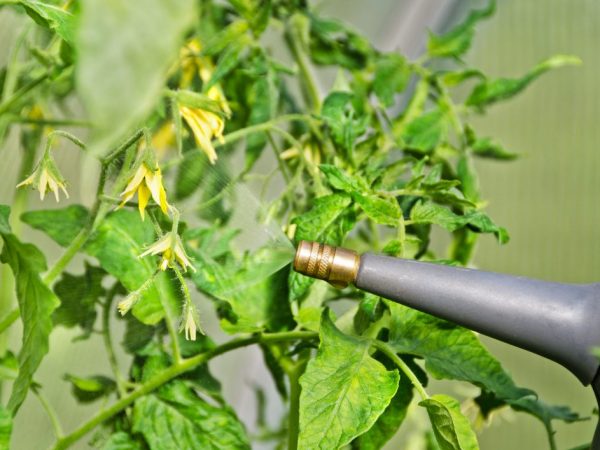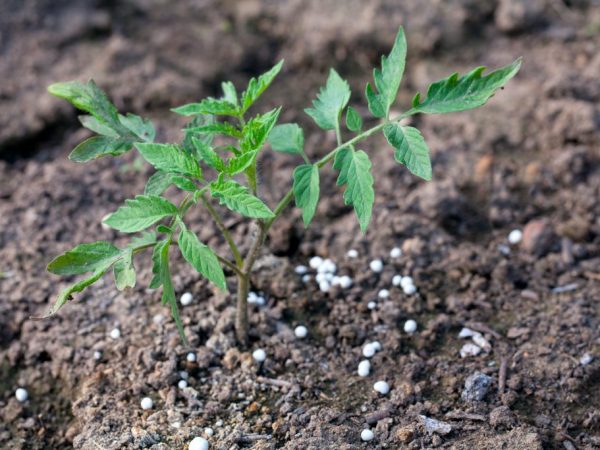Top dressing of tomatoes with superphosphate
Solanaceous crops, which include tomatoes, require balanced fertilization with mineral fertilizers for full growth. Among the effective complex fertilizers, superphosphate is distinguished. It is used for seedlings and adult plants. Feeding tomatoes with superphosphate will improve their overall growth and fruiting.

Top dressing of tomatoes with superphosphate
Properties and types
Universal complex fertilizer is widely used in horticulture. Main components:
- phosphorus;
- nitrogen;
- sulfur;
- calcium;
- trace elements.
The percentage of substances in it ranges from 25-55% phosphorus, 8-17% nitrogen, 5-10% sulfur. These indicators depend on its type.
There are the following types:
- plain;
- granulated;
- double.
Plain
Simple is produced in the form of a gray powder. The amount of phosphorus is 25-30%. Universal application, suitable for autumn application under garden and horticultural crops. It dissolves slowly in water.
Granules
Granular differs in the form of fractions. Produced in the form of granules by rolling from a moistened powder. The quantitative composition of the active ingredients does not differ from the simple one. It is convenient to use such superphosphate for tomatoes, for which dressing is applied directly to the hole or planting row.
Double
The double is more concentrated, freed from the ballast content of CaSO4. Contains 40-55% phosphorus. Used in different phases of plant growth. Let's dissolve well. Most often, feeding tomato seedlings is carried out with double-acting superphosphate.
Benefits for tomatoes
They are referred to as long-acting agents. Phosphorus and nitrogen are essential elements for proper nutrition of tomatoes. It is absorbed by plants slowly and only in the amount that is needed. When using such a substance, it is observed:
- improved germination;
- development of a healthy root system;
- intensive growth and green mass gain;
- an increase in the number of fruits;
- improving the color, size and shape of the fruit.
The use of mixtures allows the root system to become more powerful.
The introduction is carried out at different stages of soil preparation for planting tomatoes. And also during different periods of growth.
Fertilizers are applied to improve the quality of depleted soil, in cases of low mineralized soil with a phosphorus deficiency. Plants that are grown on such soil experience stunted growth. Such feeding is carried out in the fall or spring before planting seedlings in the garden.

Fertilizer can be applied to the wells before planting
During the period of active growth, feeding with superphosphates of growing tomatoes is carried out three times:
- 14 days after planting seedlings in the ground.
- At the beginning of flowering.
- When the fruits begin to set in large quantities.
And also in cases of detection of symptoms, which indicate a lack of trace elements, additional feeding is necessary. Tomatoes with a phosphate deficiency are observed:
- change in leaf pigmentation, painted in dark green with a blue tint;
- the appearance of yellowish-rusty spots on the stems;
- the inner part of the leaf changes color, and is close to purple.
Such signs can appear at the time of a sharp cold snap, or during the process of hardening the seedlings, but with a sufficient amount of phosphorus, the color will be restored when the temperature rises. If, after the stabilization of weather conditions, changes in the color of the leaves did not occur, this is a clear symptom of a lack of trace elements. As soon as the lack of phosphorus is confirmed, it is necessary to feed the tomatoes with superphosphate to avoid stunting of growth and development.
Directions for use and dosage
Depending on the time at which it is carried out, there are different ways of feeding tomatoes with superphosphate. Technology and dosage are also different. For feeding tomatoes, the drug is applied in a dry form, embedded in the ground during autumn or spring digging, added to the ground for sowing seeds for seedlings. Watering seedlings and adult bushes in dissolved form, and also used for spraying plants.
Dry application to soil
Autumn fertilization of the tomato beds is made for the general enrichment of the soil with macro- and microelements, which will ensure the normal development of the crop in the new season. Fertilizers are applied while digging the beds. Superphosphate is used as follows: per 1 sq. m. use 50 g of fertilizer, in the case of depleted soil, the dose is doubled. They are buried in the ground no deeper than the location of the roots of tomatoes in the future, and this is approximately 30-40 cm. In this way, it is enough to fertilize the plants every 5-6 years.
Phosphate fertilizers are used during the growing season of seedlings. Added when preparing the substrate. 180 g of superphosphate and 80 g of potassium are added to 25 kg of soil for vegetable crops. This enriched mixture will be the basis for the growth of strong and healthy plants.
Often gardeners begin to fertilize the garden in the spring, before planting the grown seedlings. Use the method of continuous scattering over the bed and embedding in the soil, as in the fall. The rate for continuous application is 30-40 g per 1 sq. M. And they are also introduced directly into the hole for planting a bush. For one bush, 5 g will be enough. In the spring, they mainly use granular or double, it dissolves better and the bush will be able to get the necessary substances faster. The use of phosphate fertilizer, mixed with ash in a 2: 1 ratio, has proven itself well.
Watering and spraying
Phosphates have poor water solubility. To feed the tomatoes with superphosphate for the main feeding of seedlings and growing plants, or if a deficiency of trace elements is detected, an extract is used.
The feeding of young tomato seedlings is carried out two weeks after the pick and the solution is used. Dissolve 15 g of fertilizer and 30 g of Foskamide in 10 liters of hot water, stir well and allow to cool. The resulting solution is watered or sprayed on seedlings. This amount is enough to feed 50 plants.
To prepare the extract, the granular preparation (400 g) is poured with hot water (3 l) and left for 24 hours. Sometimes they mix. The finished solution is diluted with clean water in a proportion of 150 ml of the extract per bucket of water. You can enrich the phosphate solution with nitrogen by adding 20 g of ash to it. Water the tomatoes at the root.
They also fertilize tomatoes by spraying them with superphosphate in dissolved form. For such purposes, the hood is prepared with a lower concentration. Dissolve 1 tbsp. l. superphosphate in 1 liter of hot water. The concentrate is mixed with 10 liters of water.
Conclusion
Tomatoes, like all vegetables, require a balanced complex of nutrients for full growth and development. The correct use of chemical mixtures provides the micronutrients that tomatoes need. A sufficient amount of fertilizer applied on time will provide a high-quality harvest of tasty tomatoes.


